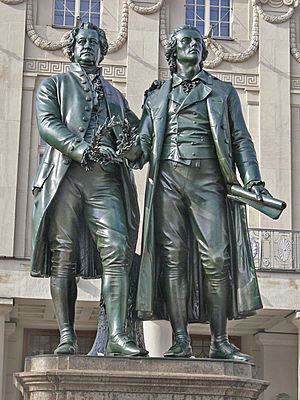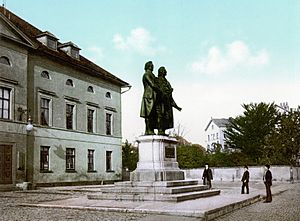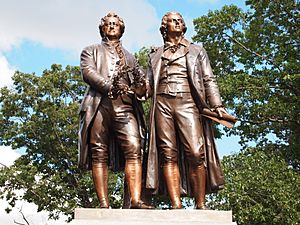Goethe–Schiller Monument facts for kids
The original Goethe–Schiller Monument is in Weimar, Germany. It features a bronze statue created in 1857 by Ernst Friedrich August Rietschel. This statue shows Johann Wolfgang von Goethe (1749–1832) and Friedrich Schiller (1759–1805). They are two of the most famous writers in German history.
Many people call this monument "one of the most famous and beloved monuments in all of Germany." It even started a trend of building more statues to Goethe and Schiller. Dozens of these monuments were later built across Europe and the United States.
Goethe and Schiller shared a special friendship and worked together often. Their partnership was unique in literature and art. Both writers lived in Weimar. They were key figures in a literary movement called Weimar Classicism. The bronze figures in the statue are larger than real life. Interestingly, both men are shown at the same height, even though Goethe was actually shorter than Schiller.
The statue stands on a large stone base. It is located in front of the Court Theater in Weimar. Goethe used to manage this theater. Many of Schiller's plays were first performed there. In the statue, Goethe is on the left. His left hand rests gently on Schiller's shoulder. Goethe holds a laurel wreath in his right hand. Schiller's right hand reaches towards the wreath. Goethe wears formal court clothes from his time. Schiller is dressed in everyday clothes.
Four exact copies of Rietschel's statue were made for German-Americans in the United States. These copies are in San Francisco (1901), Cleveland (1907), Milwaukee (1908), and Syracuse (1911). A huge crowd of 65,000 people attended the dedication of the Cleveland monument. A smaller, fifth copy was placed in Anting, China, in 2006. Anting New Town is a "German-themed" town near Shanghai.
Contents
The Weimar Monument: A Tribute to German Writers
The idea for the Goethe–Schiller monument in Weimar came from Karl Alexander August Johann. He was the Grand Duke of the Saxe-Weimar-Eisenach region. A group of citizens also supported the project. The monument's dedication was planned for the 100th birthday of an earlier Grand Duke, Karl August. He was the one who first brought Goethe to Weimar in 1775.
Goethe lived most of his adult life in Weimar. Schiller spent the last six years of his life there. The monument was placed in the city square. This square is in front of the Court Theater. Goethe was the managing director of this theater from 1791 to 1815. He once wrote that he tried to "elevate the masses intellectually" with plays by Shakespeare, Gozzi, and Schiller. Goethe arranged for the theater to premiere Schiller's last four plays. These included Mary Stuart and William Tell. By the time the monument was dedicated in 1857, the theater had shown Schiller's plays countless times.
First, Christian Daniel Rauch was asked to design a double statue. Rauch was a very famous sculptor in German-speaking Europe at the time. His design showed the two men in old-fashioned, antique clothing. However, this idea was rejected. Ernst Rietschel, another well-known sculptor and Rauch's former student, created a design that showed the men in clothes from their own time. This design was accepted, and Rietschel signed a contract in December 1852.
It took Rietschel four years to finish the full-size model for the statue. The actual bronze casting was done very quickly. Ferdinand von Miller did the casting at the Royal Foundry in Munich. The finished monument was dedicated on September 4, 1857. This was part of the celebrations for Grand Duke Karl August's 100th birthday. Experts have called the monument a "masterpiece." It was also the first double statue ever built on German soil.
Goethe and Schiller Monuments in the United States
In 1895, a group called the Goethe–Schiller Denkmal Gesellschaft (Goethe–Schiller Monument Company) was formed in San Francisco, California. Their goal was to build a copy of the Weimar Monument in Golden Gate Park. Instead of the Munich foundry, they hired the Lauchhammer foundry to make a new bronze casting. The molds for this casting came from Rietschel's original forms in Dresden. A Berlin sculptor named Rudolf Siemering oversaw the work.
The statue was placed on a granite base and steps. These closely copied the original design in Weimar. The monument was dedicated on August 11, 1901. About 30,000 people attended the event. The celebrations lasted all day and evening.
Three more monuments based on Rietschel's design were built over the next ten years. The Cleveland, Ohio monument in Wade Park was dedicated on June 9, 1907. Wilhelm II, the German Emperor, even sent a congratulatory message. The Milwaukee, Wisconsin monument in Washington Park was dedicated on June 12, 1908. About 35,000 people were there. The bronze statues for Cleveland and Milwaukee were also cast by the Lauchhammer foundry.
The statue for the Syracuse monument is made of electrotyped copper, not bronze. It was placed in Schiller Park. This park was renamed in 1905 to honor the 100th anniversary of Schiller's death. The monument was dedicated on October 15, 1911.
All the American monuments are located in city parks. The original Weimar monument is in a city square. The stone bases of the San Francisco, Cleveland, and Syracuse monuments are similar to the Weimar original. The Syracuse monument is on a steep slope. It has a long, formal stone stairway leading up to the statue. The Milwaukee monument has even more stonework. Its steps are much wider than the Weimar original. They support long stone walls and benches on both sides of the statue.
Why Were These Monuments Built?
People in the 1800s loved building monuments. These statues honored important figures. They were often placed in the most visible spots in cities. Before this, only princes and military leaders usually got such honors.
In German Lands
Building Rietschel's Goethe–Schiller statue had a clear purpose. It was to honor Weimar's famous poets and their supporter, Grand Duke Karl August. Schiller and Goethe were even buried with the Grand Duke in the ducal burial chapel in Weimar. Another reason might have been to attract "culture tourism" to the city. Weimar was known as the "Athens on the Ilm" river.
The statue was also part of a larger movement in Germany. In the mid-1800s, German-speaking people were divided into many small countries. After wars for freedom, they didn't get political freedom or national unity. So, citizens started looking for this unity in culture. They built monuments to great thinkers. This led to a "cult of the monument." People bought special books and pictures of these statues. Germans began to see themselves as "the people of poets and thinkers."
This was especially true after the failed revolution of 1848. Monuments to famous Germans, especially Friedrich von Schiller, appeared everywhere. By 1859, Schiller's 100th birthday was celebrated 440 times across German lands. Schiller became known as the "poet of freedom and unity." People saw him as a prophet of German unity. For example, in his play Don Carlos, Schiller wrote: "Look all around at nature's mastery, / Founded on freedom. And how rich it grows, / Feeding on freedom."
After the 1848 revolution failed, Schiller became even more popular. The celebrations for his 100th birthday in 1859 showed this. They were filled with patriotic feelings across Germany. The Goethe–Schiller monument was built two years earlier. But it became a national place of worship only after Germany won the war against France in 1870–1871.
In German-America
Between 1830 and 1900, about 4 million immigrants came to the United States from German countries. This was a large number of people. In the US, German immigrants often settled in less populated areas near the Great Lakes. In some regions, German immigrants and their children made up 40% of the population. For example, in 1885, about 17% of Wisconsin's population was born in Germany. With their children, about 31% of the state's population had German roots. Milwaukee, Wisconsin's main city, was even called "the German Athens in America."
Many of these German-American communities worked hard to keep their German language and culture alive. Schiller was seen as a symbol of German character. He showed how Germans could be true American citizens while keeping their heritage. During the Civil War, a quarter of a million German-born soldiers fought for Abraham Lincoln. Many of them carried Schiller's writings with them.
By the late 1800s, German-Americans also started building monuments. They joined the monument-building trend happening in German-speaking Europe. At the 1901 dedication of the first US Goethe–Schiller monument, C. M. Richter spoke. He said that Germans brought these two great writers as a gift to their new homeland. He said Schiller showed the value of goodness, the triumph of freedom, and patriotism. Richter believed this spiritual treasure was the most precious gift Germans could give to their new country. Many speeches at the dedication were given in German.
By 1901, monuments to Schiller had already been built in several US cities. These included New York (1859), Philadelphia (1886), and Chicago (1886). The Chicago and St. Louis monuments were copies of a bronze statue by Ernst Rau from 1876. That statue is in Marbach, Germany, where Schiller was born. A monument to Goethe was also built in Philadelphia (1891).
By 1914, when World War I began, eight more monuments to Schiller had been built in the US. Four of these were the double monuments to both Goethe and Schiller. Four others were dedicated to Schiller alone. These were in Omaha (1905), St. Paul (1907), Rochester (1907), and Detroit (1908). An additional monument to Goethe was built in Chicago (1914). This monument was different. It showed an idealized figure, not a clear portrait of the poet.
Overall, the desire to build monuments was strong in German-America. It was just as strong as in German-speaking Europe. Thirteen monuments to Schiller were built in the US. In comparison, 24 were built by the much larger German-speaking population in Europe.
Images for kids
-
1901 San Francisco
-
1907 Cleveland
-
1908 Milwaukee
-
1911 Syracuse









